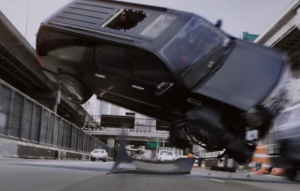 Many words have been used to describe Deadpool – mercenary, victim, smartass, mutant, supervillain, savior, anti-hero, assassin, and of course, chimichanga aficionado.
Many words have been used to describe Deadpool – mercenary, victim, smartass, mutant, supervillain, savior, anti-hero, assassin, and of course, chimichanga aficionado.
But today, we’re going with genius physicist.
Go with me here.
Trailers and teasers for the Deadpool movie have included a scene with ‘Pool drawing a picture while sitting on an overpass to Salt ‘n Peppa’s “Shoop.” As the scene unfolds, we see that Deadpool has been waiting for something – once he sees a car headed his way, he stands up, steps off the overpass and drops – breaking through the sunroof of an SUV filled with bad guys.
Punch and kick and kill stuff picks up from there, and the scene ends in a huge car wreck and shootout.
Here – you can watch it for yourself (by the way, if you look for it, you’ll see that the radio is playing “Shoop” – it’s on the display right before Deadpool’s head is smashed into it):
Let’s focus on how Deadpool got into the car.
(Full disclosure, I use this scene from Deadpool as the basis for a lab practical in my Physics course, and possibly as an extra credit assignment where student analyze the scene and tease out all the physics behind it, both plausible and impossible. But from the get go, I want to say, this isn’t being done to ruin anyone’s good time at Deadpool. It starts off with some strong physics and gets a little OCD until it reaches the end.)
The action-hero drop into or onto a moving vehicle is a pretty common event in action films and television shows. It’s a great stunt – both visually and metaphorically (think about what it conveys to the viewer about Deadpool). So let’s get into the science, and by science, we mean physics.
Breaking the drop down into pieces, getting Deadpool off of the overpass and into the SUV has three separate parts to worry about:
- Figuring out how long it will take the SUV to reach the overpass from the time he spots it coming toward him,
- Figuring out how long it will take him to drop from the overpass to the top of the SUV, and
- Figuring out how quickly he will have to fall to get through the sunroof before it moves out from under him, as he’s falling.
It’s all About Speed
Let’s start at the top – how long does it take the Escalade (most likely a 2014 as judged by watching the video) to get to the overpass? How could that be figured out?
Easily. All we need to know is the distance between the point directly under Deadpool (where he would hit the ground if he were to drop) and the point on the Escalade where he wants to hit, that is, the sunroof and the speed at which the Escalade is moving.
The 2014 Escalade is 203 inches long –which converts to 5.2 meters. The front of the sunroof (measured from the trailer – the sunroof in the trailer looks to be a after-dealer add-on, as it’s not quite where the Cadillac brochure says it should be) looks to be about 4.2m from the front of the car.
How far away is the Escalade when Deadpool spots it? I’m going to go with 14 car (Escalade) lengths, which is about 77.7 meters (231 feet). Why that far, especially when the distance isn’t shown in the trailer? I cheated. I’ll explain later.
I’m going to have to play fast a loose with the Escalade’s speed too (again, I’ll explain later), but it’s a highway outside a city, and the rest of the traffic looks to be moving fairly quickly, so I feel good with an estimate of 60 miles per hour (26.8 meters/second). Not too fast, and not too slow. Your mileage (literal and figurative) may vary.
So how do we figure out how long it will take the Escalade to get to the point underneath Deadpool? It’s all in the speed formula. Speed is a measure of distance divided by time, but you knew that. If anyone asks how fast your drove to get somewhere, you answer with a distance divided by time, for example, 55 miles (a distance) per (divided by) hour (a time).
Thanks to the beauty of algebra, we can rearrange the speed formula and solve for time:
time = distance/speed
Plug in our numbers:
time = 77.7 meters/26.8 meters/second
time = 2.9 seconds
So – from the time Deadpool looks up and spots the Escalade (his eyes narrow), he’s got exactly 2.9 seconds until it is directly underneath him. He’s got to hustle.
Dropping In For a Visit
The second part of our Deadpool problem is all in the timing. Step off the overpass too early and he’s in front of the Escalade as it’s barreling down the highway – or bouncing off the hood. Step off too late, and he’s bouncing off the roof. He’s got to time this perfectly.
Luckily, as I keep saying, Deadpool = physics genius.
There are a couple of ways to figure this part out, and let’s be honest here – we want to do this the simplest way. We can just measure the time he drops from the film.
Wait – didn’t I just say that we were trying to figure out how long it takes him to fall, and wasn’t there going to be some physics involved? This just sounds like a stopwatch thing.
Well, yeah.
But the thing is, we don’t know how high Deadpool is over the highway. Interstate highway standards mandate that clearance under an overpass should be at least 16 feet (4.9 meters). I’ve got a sneaking suspicion that’s not going to work for Deadpool, though – that would put him awfully close to the road, and while we can’t be sure of the distance, he is shown falling for a period of time. Falling 16 feet would barely be an eyeblink.
That leaves us with the question of is there anything interesting we can get from knowing how long he falls? Sure – we can figure out how far he falls.
Measuring the time from looking up to stepping off the overpass, I got 1 second, and then 1.9 seconds to fall – and that’s our important number.
How do we figure out how far something falls in 1.9 seconds? Can we just use the speed formula again, and solve it for distance? Nope. If you read our article about the Invisible Woman free falling in an issue of SHIELD, you’ll remember that everything falls with the same acceleration, 9.8 m/s/s. Acceleration is not speed – it’s like adding speed to speed each second. So we need a formula.
I’m old fashioned, so I pull out the kinematics formulas, and if I’m looking to solve for displacement (either vertical or horizontal) you can’t get any better than
Δy = vit + ½at2, where
Δy = displacement in the vertical
vi = initial velocity
t = time
a = acceleration (9.8 m/s/s)
When anything is being dropped (or stepping off of something) from a height, it’s initial velocity is zero, so we loose our first chunk (0 times t = 0), leaving us with ½at2 to worry about. Plugging in the numbers, we get 17 meters, which converts to just around 55 feet. And that’s to the top of the Escalade. The 2014 Escalade is 1.9 meters high, so the total height of the overpass would be around 19 meters, or about 62 feet. That’s a lot higher than a standard interstate overpass, but perhaps in the realm of a stacked overpass…per…haps?
Anyway – Deadpool falls for 1.9 seconds, and that means he falls for 17 meters, or 55 feet.
Oh, and earlier, when I said I cheated on figuring out how far the car is? I did time it out and got the 2.9 seconds. Look – none of this is taking anything away from the fact that Deadpool is still a freaking physics genius. It’s taken me just over twelve hundred words to explain this so far, and he did it all in his head in a shade under three seconds while Shoop was playing. In class, this part would have had to be figured out first, which would have helped you figure out (by estimating speed) how far away the car was when he first saw it.
Cutting It Close
The third part of our problem is the trickiest part for Deadpool. He has to break the glass of the sunroof and fall through it while the Escalade is moving 26.8 meters per second.
Let’s be honest here, and this goes to our philosophy with The Science Of… – it’s not going to happen in the real world, and we’re okay with that. Deadpool is not going to be The Martian, or any film that remotely comes close to even acknowledging real world science. The stunts in Deadpool, like in any other superhero movie are eye-candy – cool to look at, and in the end, more metaphor than anything else. Deadpool stepping off the overpass and falling through the sunroof of an Escalade going 60 mph is a signal to the audience that this isn’t our world. This is a comic book world – fantasy. Enjoy. Have fun. Anything, clearly, can happen.
But that doesn’t mean we can’t play with some numbers.
First off, how big is the sunroof?
Going from the earlier scaling, I found the sunroof opening (remember, it’s clearly aftermarket or modified for bad guys, because the 2014 Escalade’s sunroof looks nothing like what’s on that one…) to be roughly 68 centimeters wide. So again, if the Escalade is traveling at 26 meters per second, there’s just no way Deadpool can fall through the broken sunroof (he’s lose some speed when he breaks the glass, too).
But let’s play with some numbers anyway. For example, how fast was Deadpool falling when he reached the top of the Escalade (17 meters)? Again with the kinematics formula – this time, we’re using one that will tell us final velocity for an accelerated body:
vf = vi + at
vf is final velocity, and everything else carries over from the last kinematic equation.
Plugging in our numbers, and of course remembering that acceleration is 9.8 m/s/s, we see that after falling for 1.9 seconds, Deadpool is moving 18.6 m/s, which is fast, but not fast enough.
Think of it this way – the back of the sunroof’s opening (68 centimeters from the front) is coming at whatever part of Deadpool’s body that’s fallen through the opening at 26.8 m/s. In one second, the back of the sunroof opening will be 26.8 meters further down the highway. Even half a second later, it’s 13.4 meters down the highway, and on and on for a quarter of a second and smaller increments. And Ryan Reynolds is 6’ 2” (1.9 meters).
A very rough way to figure out how much time Deadpool needs to fall through the opening is to, well, get him inside. How much time does Deadpool need to fall 1.9 meters (Reynolds’ height – assuming he breaks the glass with his heels and doesn’t lose any speed as he does it. Just go with me here)?
When he’s moving at 18.6 m/s, Deadpool/Reynolds needs 0.1 seconds to cover the distance, from heels to top of head. “But,” you say, “Couldn’t that be enough time to make it fully through the sunroof if the Escalade is moving at 26.8 meters per second?”
Glad you asked.
No.
Again, we need to know how far the Escalade would move in 0.1 seconds, and if it’s more than 68 centimeters, 0.68 meters, we’re cutting Deadpool into Deadpools wherever the roof hits him.
How far does the Escalade move in 0.1 seconds?
You should be able to do this by now… speed = distance/time, and you’re solving for distance.
Distance = speed x time
Distance = (26.8 m/s)(0.1 s) = 2.68 meters = sliced Deadpool.
The next logical question to ask is, of course, how fast would Deadpool have to be falling in order to fall 1.9 meters (his height) before the Escalade’s roof chops him in two?
We want to know, in other words, how long does it take the Escalade to move .68 meters (the width of the sunroof). I/m not going to assign this as homework, but I sure could at this point…we want to know time, and we know speed and distance. Let’s just rearrange speed = distance/time to solve for time once again:
Time = distance/speed.
Time = .68 m/26.8 m/s = 0.03 seconds. In other words, the Escalade will move .68 meters in 0.03 seconds. Or, as far as we’re concerned, the back of the sunroof will be where the front was in 0.03 seconds.
Deadpool has three one-hundredths of a second to fall through that roof.
At this point, I have to give a shout to the special effects team who worked on this segment – if you watch the snippet where Deadpool is falling through the roof, he does seem to speed up. A slight nod to the idea that he’d have to be moving faster to make it inside
We’ve come this far, so let’s figure it out – how fast would Deadpool have to be falling in order to make it fully through the sunroof in 0.03 seconds? He has to get his whole body (1.9 meters) through the opening in 0.03 seconds.
You know this one, right? Solve it for speed.
Speed = distance/time
Speed = 1.9 m/0.03 s = 63.3 meters/second.
Deadpool would have to be moving downward more than twice as fast as the Escalade is moving horizontally in order to do what he does in the clip. One last thing – since he was dropping, what would his acceleration be during his drop that would result in that speed by the time he hits the Escalade?
For this one, we can use the acceleration formula:
a = vf – vi/t and I think you know all the letters by now.
Plugging numbers in, we get:
a = 63.3 m/s – 0 m/s / 1.9 seconds = 33.3 m/s/s. That’s more than the acceleration due to gravity on Jupiter. Yikes. Whichever bad guy is in his way is going to get one heck of a hit.
So where are we?
In Deadpool’s world – let’s think about what he was able to do: visually determine the distance (within about 20 centimeters) between himself and a car speeding towards him; calculate not only how long it would take said car to reach him, but also how long it would take him to fall from his height to the roof of the car; and finally…well…um…somehow increase the effect of gravity on him so he fell faster when he needed to.
Even Neil deGrasse Tyson can’t do that.











